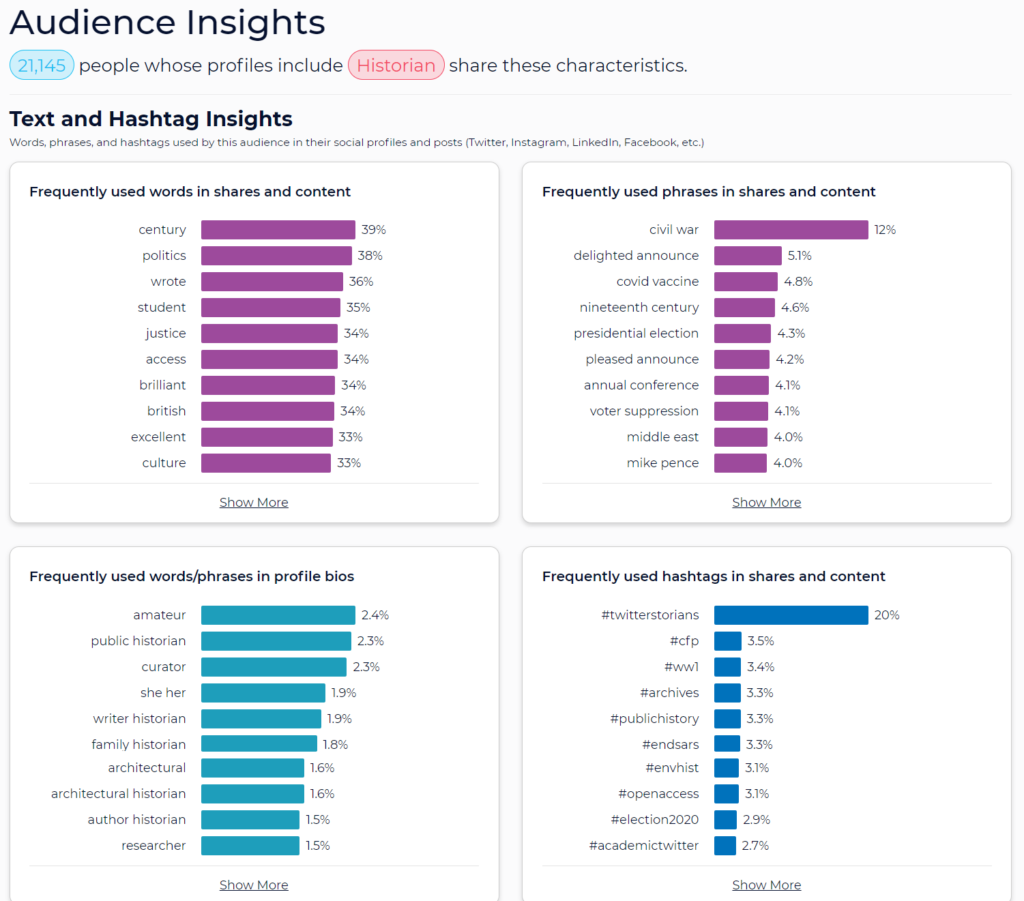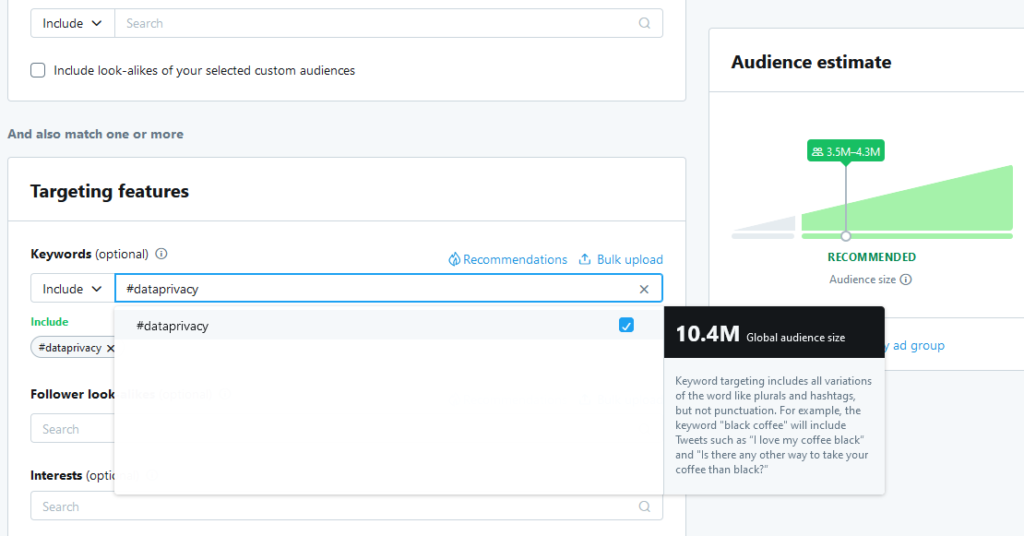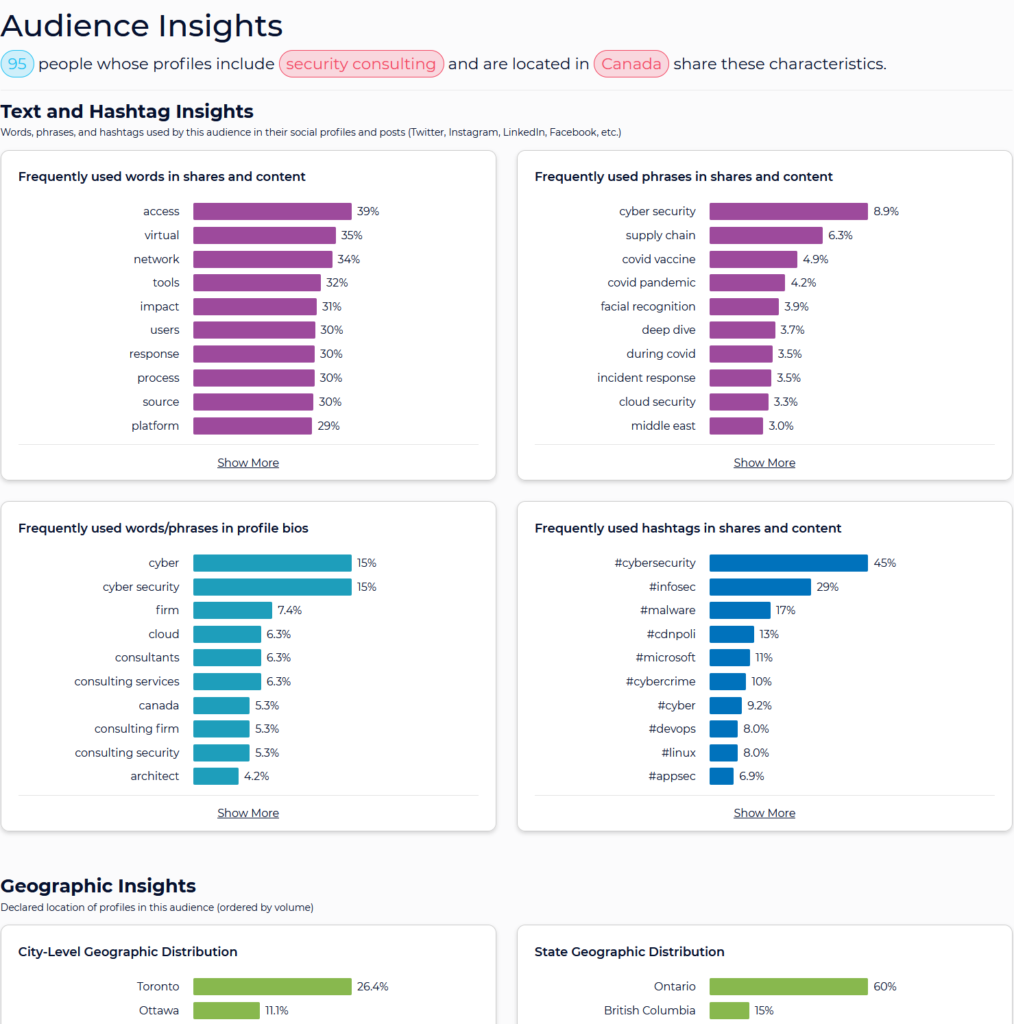Just last week we released the new Press tab, but we’re at it again with another upgrade for your SparkToro account—albeit a more modest one. Today, we’re excited to announced an upgraded Audience Insights tab with more data available, and new segmentation of text insights. All the details and a few examples of how you might apply this data are below.
When you search for an audience in SparkToro, starting now, you’ll see four boxes of information atop the Audience Insights tab.

These are, in order from top-left to bottom-right:
- Frequently used words in shares and content – these words are extracted from public posts on social networks of profiles that share the searched-for characteristics. In the example above, almost 40% of profiles containing “historian” posted something with the word “century” in the past ~100 days.
- Frequently used phrases in shares and content – these multi-word phrases are, similarly, extracted from those same public posts, but they’re often much more valuable than singular words. In the historian example, “voter suppression” may be less common than “century,” but it’s also more useful for tasks like audience research, ad targeting, keyword research, content ideation, and more.
- Frequently used words/phrases in profile bios – SparkToro crawls public profiles across 10 social networks, and when we do, we pay special attention to the fields LinkedIn and Facebook call “About,” Twitter and Instagram call “Bio,” and other networks call “Profile.” The words and phrases shown in this section of Audience Insights come from those labeled fields, and include fascinating data that’s particularly applicable to persona creation, audience research, and ad targeting.
- Frequently used hashtags in shares and content – Hashtags come mostly from the shares/posts/content we find on Instagram and Twitter (sometimes Pinterest, too). They’re exceptionally useful as social amplification and ad targeting insights, and I also find great value in clicking them to perform additional searches for similar or more specific audiences (full process described here).
But it’s not just more text data types, we’re also displaying more rows of information, too. In the upgraded Audience Insights section, you’ll now get the top 50 text characteristics for each of these four sections (with a paid account), or the top 20 (with a free account).

This increased data is available in both the SparkToro UI as well as the XLS/CSV exports you can access for any search.
Applying Text Insights
For so many years of my marketing career, getting data about what a particular audience was talking about, how they described themselves, which hashtags they used, et al. was an infuriatingly manual, time-consuming, unrealistic process. So, it’s truly exciting to me that in 3 or 4 seconds, I can now retrieve this data about *any* online group I want.
But, the use-cases aren’t always obvious. So I thought I’d share a few of the ways I’ve been applying this information as well as the creative uses I’ve seen from SparkToro’s customers.
Massively Better Ad Targeting
If you’ve used Facebook, Instagram, Google Display, YouTube, Pinterest, or Twitter Ads in the last couple years, you’ve likely been infuriated to find these platforms pulling away their previously more structured and easy-to-use targeting features. The joint forces of privacy-theater and the platforms’ incentives around broad-targeting (so we all spend more reaching bigger, but not necessarily more relevant audiences) drove this change. As a result, it’s harder than ever to reach the precise groups you want through the default ad tools.
For example, here’s Twitter’s ad targeting interface (Facebook/Instagram look extremely similar):

If you know exactly what to type into the “keywords,” “interests,” and “conversation topics” boxes, you can reach some very targeted groups on these platforms. But if you’re not sure which words and phrases your potential customers are using on social, you’re up a creek. Facebook, Twitter, Instagram, Pinterest, and Google/YouTube are ludicrously unhelpful here.
SparkToro to the rescue!

By knowing which hashtags, words, and phrases the audience you want to reach is using, you can craft truly targeted ad groups. We’re seeing a lot more social and display advertisers turn to the Audience Insights for exactly this purpose. It’s weirdly heartwarming to know that our product’s helping people circumvent these manipulative systems designed to prevent thoughtful, well-targeted ads and yank extra dollars from our ad budgets. Better targeting = better ads = better ROI.
Content Strategy & Content Marketing
If you’re seeking to create content likely to resonate with audiences on social platforms, and capture the zeitgeist of current discussions in a space, the text insights can be invaluable.
I think of it like this:
- Frequently used words/phrases in bios = who I’m writing for
- Frequently used words/phrases in shares+content = what they’ve recently been interested in
For example, if I’m looking to target the data security space…

…I’ll want to reach folks who are in compliance, privacy, cybersecurity, consultancies (and those serving clients), innovation, policy, etc. And I’ll likely want to cover topics like cyber attacks, cloud computing (and hybrid cloud) security, issues arising from Covid, supply chain issues, facial recognition (that one’s particularly salient right now), European elections (and the European commission on data privacy), etc.
This certainly isn’t the only way to brainstorm topics, but it’s one of the most data-driven. When you’ve got a substantive audience in SparkToro, and you know that 9.4% are actively talking about facial recognition, it’s a heck of a strong signal that’s a subject worth covering.
Conversation & Topic Discovery
Even if you’re not a content creator, when you’re building products, crafting marketing campaigns, or otherwise attempting to serve an audience, you should know what’s happening in their world.
For a number of SparkToro’s customers in the marketing and product strategy worlds (particularly those advising clients or heading up teams), the ability to bring data to these discussions is powerful. I had plenty of times in my previous career when trying to convince product teams, engineers, marketers, VPs, other execs, or even my board of directors that we should invest in some particular trend. Search data from something like Google Trends can help, for sure:

But adding conversational data with actual percentiles from audiences I know were our target customers (and/or those of our competition)? That would have made a huge difference.

There are alternatives, too—social listening tools like Crimson Hexagon/Brandwatch, Mention, Sprout Social, etc. Most of these don’t provide the audience intel you’ll find in SparkToro, but they do offer additional features we don’t (sentiment analysis, demographics, interest graphs, etc). However, they’re extremely expensive, enterprise solutions ($10-25K/yr+), and I couldn’t find any that offer a free version.
Audience Research & Persona Crafting
If you’ve done traditional persona-building, you’re probably familiar with outputs like this:

Via Infegy
Being totally honest, I don’t get demographic personas, especially outside of the big, Fortune 2000, consumer-focused brands. Would knowing that 51% of my SaaS company’s B2B customer targets are women, or that 11% of their “online emotions” are “Trust” do anything for my marketing strategy?
¯\_(ツ)_/¯.
I’m wracking my brain, but can’t come up with a use for this kind of data. And yet, almost every audience research project includes some expensive, time-consuming acquisition process wherein marketers run big surveys, buy research data from third-parties, or extract samples from their customer database to run custom analyses.
If those processes and that data are useful to you, by all means, keep at it. But my guess is that appending percentile data about what those audiences read, watch, listen-to, follow, engage-with, talk-about, have in their bios, etc. are far more valuable additions.

Even when SparkToro has a relatively small audience, e.g. this group of 95 professional security consultants located in Canada, the percentile data can be extraordinarily useful for crafting better, more actionable personas.
Social Media Marketing
Who, in the social universe, should you build relationships with? Follow? Engage-with? Watch? Get introductions to? Ask to amplify your messages? SparkToro’s social tab has always been good at answering these.
The expanded text insights can help with another set of questions social marketers often have, like:
- Which hashtags are my audience(s) using? And which ones should I follow?
- What topics, phrases, and keywords are getting the most activity among my targets?
- How do members of my community describe themselves? What could I search for to find more people/accounts like them?

All that data is right at your fingertips in the Audience Insights tab.
Keyword Research
Last, we’ve got my old stomping ground of SEO. The overlap between search keywords and words/phrases used in social content isn’t 1:1, and so this use-case requires some fine-tuning and usually, that addition of another, more search-keyword-focused tool (like Moz’s KW Explorer, below).

Taking topic and text data from the Insights tab in SparkToro and using it as a search term in Keyword Explorer (or your choice of other SEO products) is a solid way to get information about what’s likely of interest to an audience on the social web and in the search results. More detail on how to employ SparkToro’s unique keyword research outside of search marketing here.
The list above, of course, isn’t exhaustive. There’s loads more useful applications for this data in the worlds of market research, audience intelligence, and digital marketing. If you’ve got use-cases to share, or creative thoughts we haven’t considered, we’d love to hear ’em! Every time we learn more about how people are using the product, we get new ideas for how to make it better 🙂
P.S. This upgrade is just the first step; we’re actively looking at other options for extracting topics, entities, brand names, concepts, etc. from the billions of posts and shares SparkToro finds. Stay tuned for more in the months ahead!